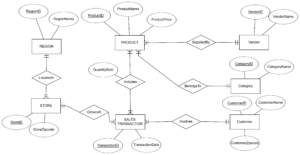
As a data engineering consult on this project, we had the opportunity to spearhead the creation of a comprehensive database system to streamline the sales process for ZAGI Retail Company. By carefully extracting requirements from internal interviews and company documentation, I crafted an Entity-Relationship Diagram (ERD) that serves as the blueprint for our operational database.
- Key Components of the Database: This database is designed to streamline sales processes. Key components of the databes are:
- Products: Capturing essential details such as product ID, name, and price.
- Categories: Organizing products into categories with unique identifiers.
- Vendors: Recording vendor information including ID and name.
- Customers: Managing customer data such as ID, name, and zip code.
- Stores: Tracking store locations with unique IDs and zip codes.
- Regions: Mapping stores to regions, each with a unique identifier and name.
- Sales Transactions: Recording transaction details like ID and date.
- Relationships: Establishing vital connections between entities, ensuring data integrity and accuracy.
Operational Database Schema: The ERD was meticulously transformed into a relational schema, laying the foundation for an efficient and scalable operational database. Key considerations included data normalization, indexing strategies, and query optimization to enhance performance and usability.
Benefits: This database solution empowers ZAGI Retail Company to manage sales processes seamlessly, from product inventory to customer transactions. With a clear structure and robust relationships, the database facilitates data-driven decision-making, enhances productivity, and fosters customer satisfaction.
Designing and implementing this operational database was a pivotal step towards modernizing ZAGI Retail Company’s sales operations. It’s a testament to our commitment to innovation and efficiency, and we are excited to see the positive impact it will have on our business success.
